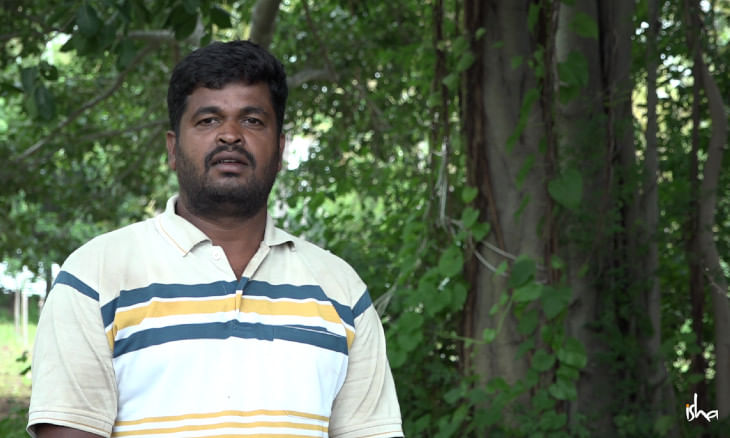Share
A MBA-Turned Farmer’s Tryst with Tree-Based Agriculture
Field Stories
03 Nov 2022
07:53 am
A well-planned farm is a jackpot, discovered Shyamsundar of Ramanagara District in Karnataka. An MBA graduate and an urban migrant, his Land kept tugging at his heartstrings till finally the Mannina Maga (son of the soil) returned to his farming roots and transformed his farm into a revenue rich enterprise.

When the Cauvery Calling team met him, this enterprising farmer was eager to share his success with the tree-based farming model.
You can take a farmer out of his farm but you can’t take the farm out of the farmer. And that’s just as well. “Why is the farmer facing hard times?” asks Shyamsundar, a farmer from Marigondanatoti village in Ramanagara District of Karnataka. He answers his own rhetorical question, “Because he’s not getting continuous income, money is not rotating. Any society, any economy, if the money rotates, only then it will go smoothly; otherwise, it will be very difficult.”
Shyamsundar migrated to Bengaluru, got an MBA degree and ended up in a multinational company - a route that hundreds (if not thousands) of young boys from rural Karnataka have taken before him. “If there are 100 boys in a village, 95 will go to Bangalore,” says Shyamasundar. He was one of them. He spent six and a half lackluster years behind a desk while a part of him kept pining for his farm. He also wanted to encourage the youth to stay on the land. He was combing the net, looking for a civic organization to support him when he chanced upon the Cauvery Calling mission to revive river Cauvery by placing a third of the river basin area under shade. The project promotes tree-based agriculture on private farmlands to achieve its goal. “It came to my mind that if I start normal agriculture, it will be very difficult,” he says, defining ‘normal agriculture’ as labour intensive, driven by chemical fertilizers and supported by cost prohibitive irrigation systems.
Then, Shyamsundar launches into what can only be described as a master class in agricultural planning. “Economics was my favourite subject. I had studied it theoretically. Now, I thought of applying it practically in agriculture,” he declares. “I thought about what we need: daily income, weekly income, monthly income and annual income.” This thought became the foundation on which he structured his cropping pattern. “Monoculture is always dangerous. People who monopolize only could not be saved, how can those who practice monoculture be saved?” Hear, hear!
“For daily income, I planted rose. Soon after, I planted lemons and once they started yielding, I stopped floriculture. Lemons give me daily and weekly income. My cows gives me income every 15 days; sericulture once a month; fruit trees like guava and chikoo, once in six months; mangoes and the like once a year and every 10-15 years, I get large sums of money from tree-based farming when I harvest teak, sandalwood, melia dubia, etc.” he explains. “There are so many kinds of fruits that yield at different times. We also grow vegetables for our own consumption,” say the clever farmer whose common sense cultivation has reduced his daily household expenses and improved his income. He not only made 8-10 lakhs harvesting his high-value timber, he even found a way to reduce irrigation costs: Mulching. “I collected all the leaves from my farm, created a bed for all plants and filled that bed with these leaves. And then we watered the plants once a week with drip irrigation.” Trees generate income and reduce expenses, says Shyamsundar.
But doesn’t all this need a lot of land? Shyamsundar says this is what stops most farmers but it shouldn’t. “Don't lose your mind,” he advises. “Grow as many trees on the boundary as possible and in the middle, do agriculture. In only 2 acres of land, two engineers have grown coconut, vegetables, and so many other crops.” He also quotes the example of his own farm. “I have been growing Mulberry, planted in rows. He puts the space between mulberry rows to good use. “I grow garlic, pigeon pea, black-eyed peas and maize; because I grow all this, I get fodder for the cows.” When mulberry rates crashed during COVID, he used it as fodder for his goats. “If you plan like this, then you will not have any problems.” And then comes the double-whammy: “No need to drink pesticide and die. No need for pesticide at all.”
Editor's Note: The Cauvery Calling Movement was launched by Sadhguru in 2019 to revitalize Cauvery River and bring wellbeing to 84 million people. Cauvery Calling is the world’s largest farmer-driven ecological movement and is supporting 5.2 million farmers to plant 242 crore trees in farmlands. Make your contribution online to save Cauvery. Donate ₹42 per tree at cauverycalling.org. Action now!
Related Stories
In Focus: Sadhguru at COP29
13 Feb 2025
05:28 am
From impactful discussions to electrifying moments at the United Nations Framework Convention on Climate Change (UNFCCC) COP29 in Baku, Azerbaijan, watch Sadhguru captivate global leaders with a bold vision for ecological restoration and a call to action that resonates beyond borders.
Empowering 34,000+ Farmers in Karnataka and Tamil Nadu through Cauvery Calling WhatsApp Groups
21 Nov 2023
07:50 am
Cauvery Calling is supporting over 34,000 #farmers daily via WhatsApp groups in Karnataka and Tamil Nadu to help them transition to #treebasedagriculture. Topics include model farmer videos, event updates, timber selection tips, and planting methods based on soil type, depth, salinity, etc.
Award-Winning Innovation: From Monocrop to Food Forest
17 Dec 2024
04:16 am
Discover how Mr. Valluvan transformed a traditional coconut farm into a thriving food forest, earning global recognition at UNCCD COP16 and the World Soil Day 2024 Farmer Contest. Click to explore his inspiring journey!
Keep In Touch
Get the latest Cauvery Calling updates delivered to your inbox.
